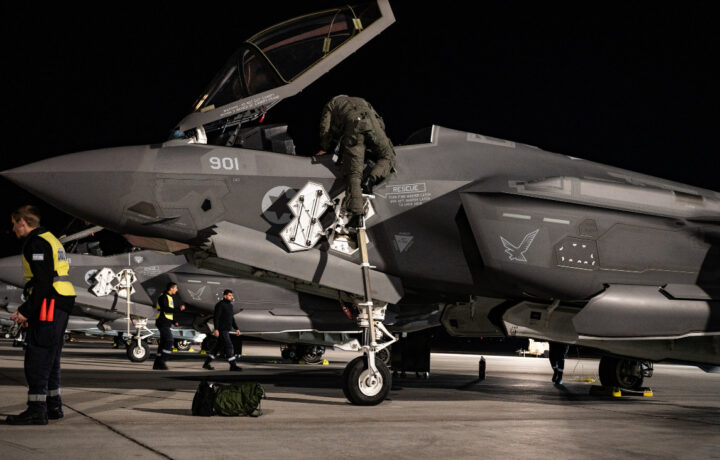Last Friday, Israel carried out a massive air assault on Iran, striking the Islamic Republic’s nuclear facilities, while also targeting multiple top military officials and even atomic scientists. Part of the success was due to efforts of the Mossad intelligence agency, which carried out missile and drone attacks from within Iran, crippling the country’s air defense systems.
It was the most significant aerial attack ever carried out by the Israel Defense Forces (IDF), greatly eclipsing 1981’s Operation Opera, which saw just over a dozen American-made F-15 Eagles and F-16 Fighting Falcons target Iraq’s nuclear facilities before it could be brought online. By contrast, Operation Rising Lion included 200 fighters, including the F-35I Adir, the Israeli-specific variant of Lockheed Martin’s fifth-generation stealth fighter.
Though Iranian media have reported that Tehran successfully downed as many as three F-35s, Israel has refuted the claims.
Could America Pull Off Such an Aerial Assault?
A big question now being asked is whether the United States has the capabilities to carry out such a brazen assault if ever needed.
The short answer is yes.
Yet, as John Venable, senior resident fellow for airpower studies at AFA’s Mitchell Institute for Aerospace Studies, told Air & Space Forces magazine, the U.S. Air Force could pull off such a sortie, but it wouldn’t be sustainable. Venable, a retired Air Force colonel, explained that the issue would be how many aircraft the Air Force kept in reserve for the defense of the United States.
Israel is a far smaller country, roughly the size of New Jersey, and it is much closer to Iran.
The U.S., after holding back fighters, would have a deployable force of 480 fighters that would need to be sent to the region to carry out any attacks. However, Venable noted that the U.S. Air Force has a mission-capable rate of “just over 60%,” which means that if all of those fighters were deployed to the region, only 288 could be mission-capable for the initial sortie. Due to a lack of spare parts, the second sortie would be reduced to fewer than 200 jets.
Pilot Shortage is Another Problem
Beyond the less-than-stellar mission-capable rate, the Air Force continues to be plagued by a lack of trained and experienced pilots. Inexperienced aviators are worse than no aviator, as they can make mistakes resulting in their loss along with their aircraft. Training is expensive and time-consuming, while replacing any downed aircraft is even more costly and time-consuming.
“Due to a drought in training sorties, there isn’t a single squadron in the Air Force that is mission-ready,” Venable told Air & Space Forces magazine. “Pushing them into a threat environment without those ‘reps and sets’ of confidence would likely mean we would suffer much more attrition than whatever the Israelis suffered, and much of that would be caused by mishaps refueling or even recovering back at home base.”
The U.S. Still Knows “Shock and Awe”
Even as Venable issued a stark assessment of what the U.S. Air Force could bring to the fight, it fails to address a couple of other factors.
First, the U.S. Navy is now operating the Nimitz-class nuclear-powered supercarrier USS Carl Vinson (CVN-70) in the Arabian Sea, while USS Nimitz (CVN-68) was reported to be steaming to the region on Monday. Each of those carriers was designed to carry upwards of 90 aircraft.
Both have embarked air wings of Boeing F/A-18 Super Hornets, while CVN-70 has deployed F-35C Lightning IIs, the carrier-based version of the Joint Strike Fighter. The F-35C has the highest mission-capable rate of the Lightning II, and the U.S. Navy’s aviators won’t need to fly halfway across the world to deploy; they’re already on the carriers and ready to take off as needed.
The U.S. Navy carrier-based fighters could support sorties carried out by something else that the IDF lacks, such as long-range strategic bombers. The United States Air Force deployed around six Northrop B-2 Spirit bombers to the island of Diego Garcia earlier this spring, while an undisclosed number of B-52s were also believed to have been sent to the British island territory.
Around three dozen aerial refueling aircraft are already being deployed to Europe, which could signal that other B-2 Spirits, B-52s, or even Rockwell B-1 Lancers could be sortied from bases in the United States and sent on CONUS-to-CONUS missions as was done during Operation Iraqi Freedom and Operation Enduring Freedom.
It was more than two decades ago, but the U.S. carried out its “Shock and Awe” campaign against Iraq. It included more than 1,800 aircraft in total, with half belonging to the U.S. Air Force. That was a reminder that the U.S. military can be genuinely an unstoppable force.
Yet, it would still be a perilous mission, one that would put U.S. aircrews in danger.



